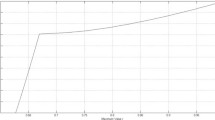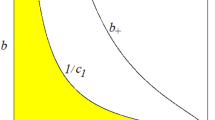Abstract
In this paper, we show how a rich variety of dynamics may arise in a simple multiplier–accelerator model when a nonlinearity is introduced in the investment function. A specific sigmoidal functional form is used to model investments with respect to the variation in national income, in order to bound the level of investments. In fact, due to obvious material constraints, business strategies cannot sustain infinite investments. With the aid of analytical and numerical tools, we investigate the stability conditions, bifurcations, as well as periodic and chaotic dynamics for different specifications of the model that may include or not an endogenous government expenditure. We obtain some comparative statics results that shed light on the stabilizing or destabilizing role of the various parameters in the model. Globally, we study multistability phenomena, i.e., the coexistence of different kinds of attractors with a rich and complex dynamic structure.















Similar content being viewed by others
Notes
Or periodic oscillations with a very high period. In discrete-time maps, the Neimark–Sacker bifurcation occurs when a pair of eigenvalues cross the unitary circle of the complex plane. Thus, remarkable differences can be evidenced (with respect to the continuous time case), concerning the kind of motion along the closed invariant curve created at the bifurcation (it is no longer a unique trajectory but the closure of infinitely many distinct trajectories, either periodic or quasiperiodic) and the fate of such invariant curve as the parameters move far from their bifurcation values.
References
Samuelson, P.A.: Interactions between the multiplier analysis and the principle of acceleration. Rev. Econ. Stat. 21, 75–78 (1939)
Hicks, J.R.: A Contribution to the Theory of the Trade Cycle. Clarendon Press, Oxford (1950)
Day, R., Chen, P.: Nonlinear Dynamics and Evolutionary Economics. Oxford University Press, Oxford (1993)
Hommes, C.H.: A reconsideration of Hicks’ non-linear trade cycle model. Struct. Change Econ. Dyn. 6, 35–459 (1995)
Rosser, J.B.: From Catastrophe to Chaos: A General Theory of Economic Discontinuities, 2nd edn. Kluwer Academic Publishers, Boston (2000)
Puu, T., Gardini, L., Sushko, I.: A Hicksian multiplier-accelerator model with floor determined by capital stock. J. Econ. Behav. Organ. 56, 331–348 (2005)
Chiarella, C., Flaschel, P., Franke, R.: Foundations for a Disequilibrium Theory of the Business Cycle: Qualitative Analysis and Quantitative Assessment. Cambridge University Press, Cambridge (2005)
Puu, T., Sushko, I.: Business Cycle Dynamics. Springer, Berlin (2006)
Sushko, I., Gardini, L., Puu, T.: Regular and chaotic growth in a Hicksian floor/ceiling model. J. Econ. Behav. Organ. 75, 77–94 (2010)
Agliari, A., Dieci, R., Gardini, L.: Homoclinic tangles in a Kaldor-like business cycle model. J. Econ. Behav. Organ. 62, 324–347 (2007)
Li, S., Li, Q., Li, J., Feng, J.: Chaos prediction and control of Goodwins nonlinear accelerator model. Nonlinear Anal. Real World Appl. 12, 1950–1960 (2011)
Bischi, G.I., Dieci, R., Rodano, G., Saltari, E.: Multiple attractors and global bifurcations in a Kaldor-type business cycle model. J. Evol. Econ. 11, 527–554 (2001)
Naimzada, A., Pireddu, M.: Dynamics in a nonlinear Keynesian good market model. Chaos 24, 013142 (2014)
Agliari, A., Bischi, G.I., Dieci, R., Gardini, L.: Global bifurcations of closed invariant curves in two-dimensional maps: a computer assisted study. Int. J. Bifurc. Chaos 15, 1285–1328 (2005)
Ma, J., Sun, T., Wang, Z.Q.: Hopf bifurcation and complexity of a kind of economic systems. Int. J. Nonlin. Sci. Num. 8, 347–352 (2007)
Ma, J., Gao, Q.: Stability and Hopf bifurcations in a business cycle model with delay. Appl. Math. Comput. 215, 829–834 (2009)
Ma, J., Tu, H.: Analysis of the stability and Hopf bifurcation of money supply delay in complex macroeconomic models. Nonlinear Dyn. 76, 497–508 (2014)
He, X., Li, C., Shu, Y.: Bifurcation analysis of a discrete-time Kaldor model of business cycle. Int. J. Bifurc. Chaos 22, 1250186 (2012)
Gu, E.G.: Complex Dynamics in a Model of Common Fishery Resource Harvested by Multiagents with Heterogeneous Strategy. Int. J. Bifurc. Chaos 25, 1550153 (2015)
Guckenheimer, J., Holmes, P.J.: Nonlinear Oscillations, Dynamical Systems, and Bifurcations of Vector Fields. Springer Science & Business Media, Berlin (2013)
Kaldor, N.: A model of the trade cycle. Econ. J. 50, 78–92 (1940)
Goodwin, R.M.: The nonlinear accelerator and the persistence of business cycles. Econometrica 19, 1–17 (1951)
Albers, D.J., Sprott, J.C.: Routes to chaos in high-dimensional dynamical systems: a qualitative numerical study. Physica D 223, 194–207 (2006)
Ding, M., Grebogi, C., Ott, E.: Evolution of attractors in quasi-periodically forced systems: from quasi-periodic to strange non-chaotic to chaotic. Phys. Rev. A 39, 2593 (1989)
Elhadj, Z., Sprott, J.C.: A minimal 2-D quadratic map with quasi-periodic route to chaos. Int. J. Bifurc. Chaos 18, 1567–1577 (2008)
Reick, C., Mosekilde, E.: Emergence of quasi-periodicity in symmetrically coupled, identical period-doubling systems. Phys. Rev. E 52, 1418 (1995)
Medio, A., Lines, M.: Introductory notes on the dynamics of linear and linearized systems. In: Nonlinear Dynamical Systems in Economics. Springer Wien, NewYork: CISM, 1–26 (2005)
Author information
Authors and Affiliations
Corresponding author
Ethics declarations
Conflict of interest
The authors declare that they have no conflict of interest.
Rights and permissions
About this article
Cite this article
Naimzada, A.K., Pecora, N. Dynamics of a multiplier–accelerator model with nonlinear investment function. Nonlinear Dyn 88, 1147–1161 (2017). https://doi.org/10.1007/s11071-016-3301-4
Received:
Accepted:
Published:
Issue Date:
DOI: https://doi.org/10.1007/s11071-016-3301-4




